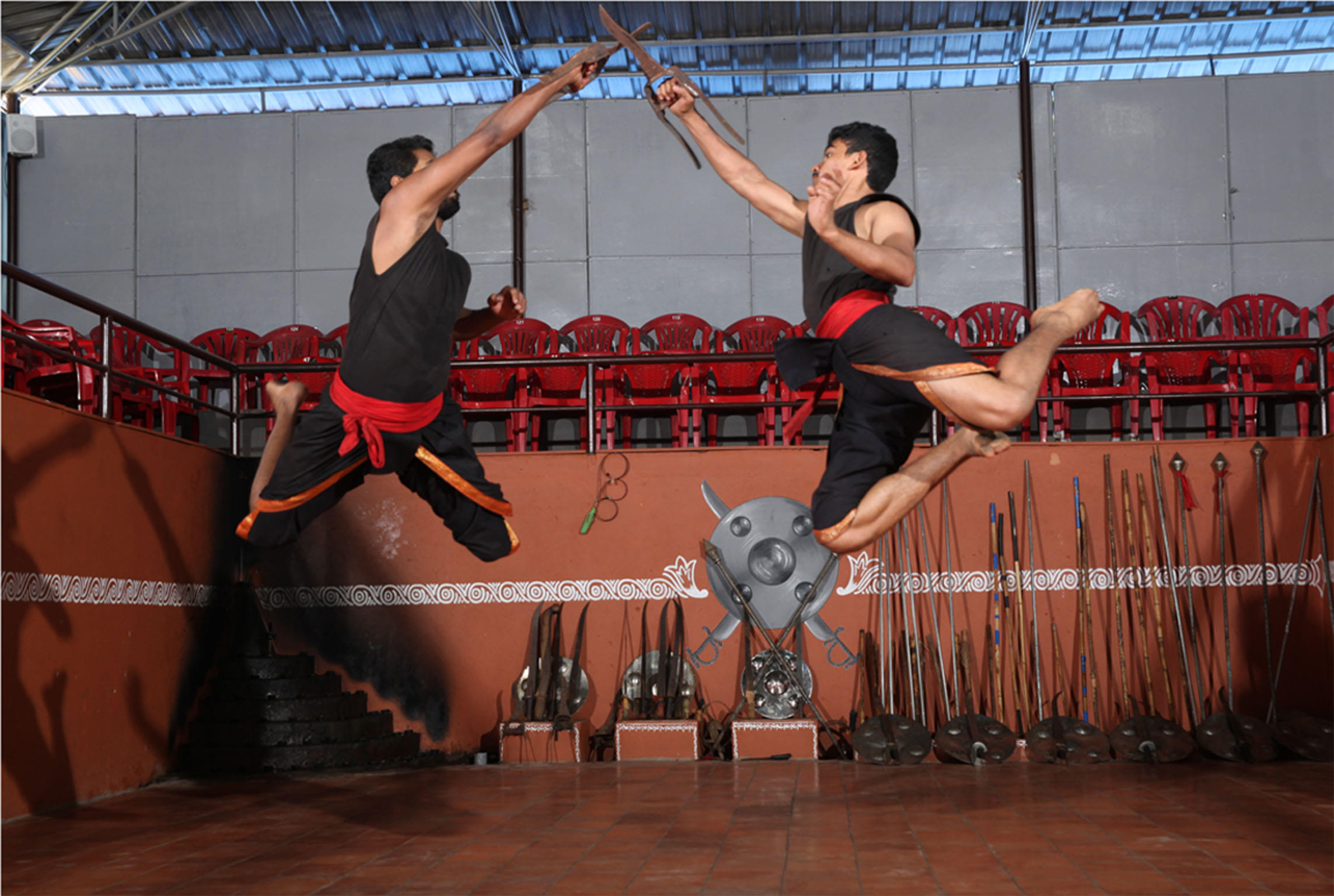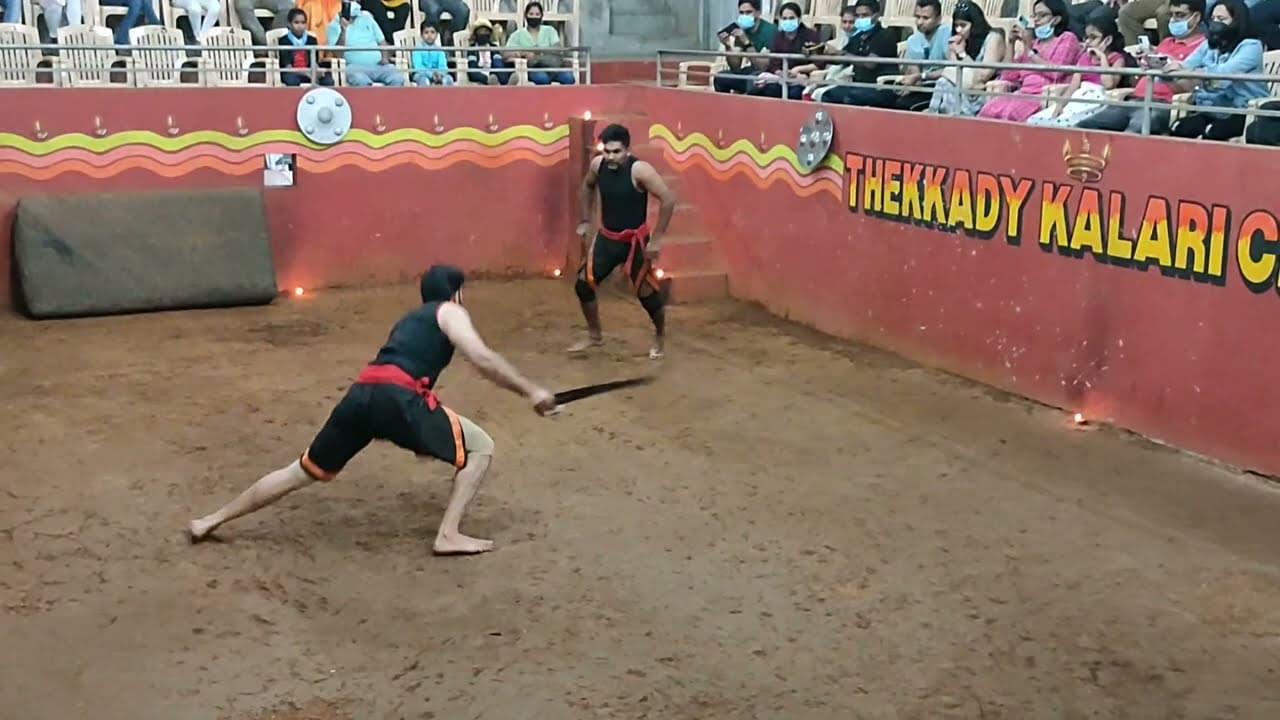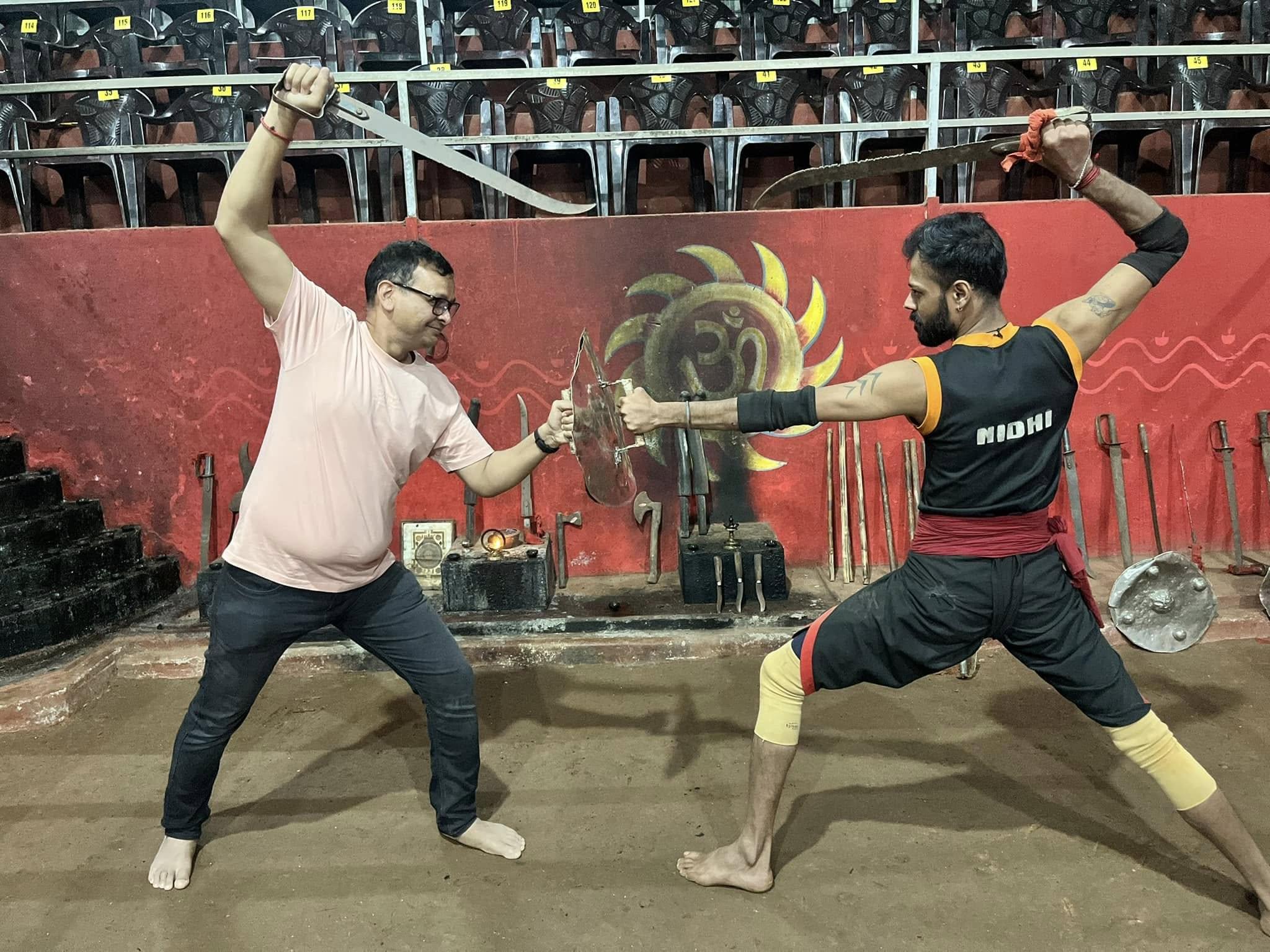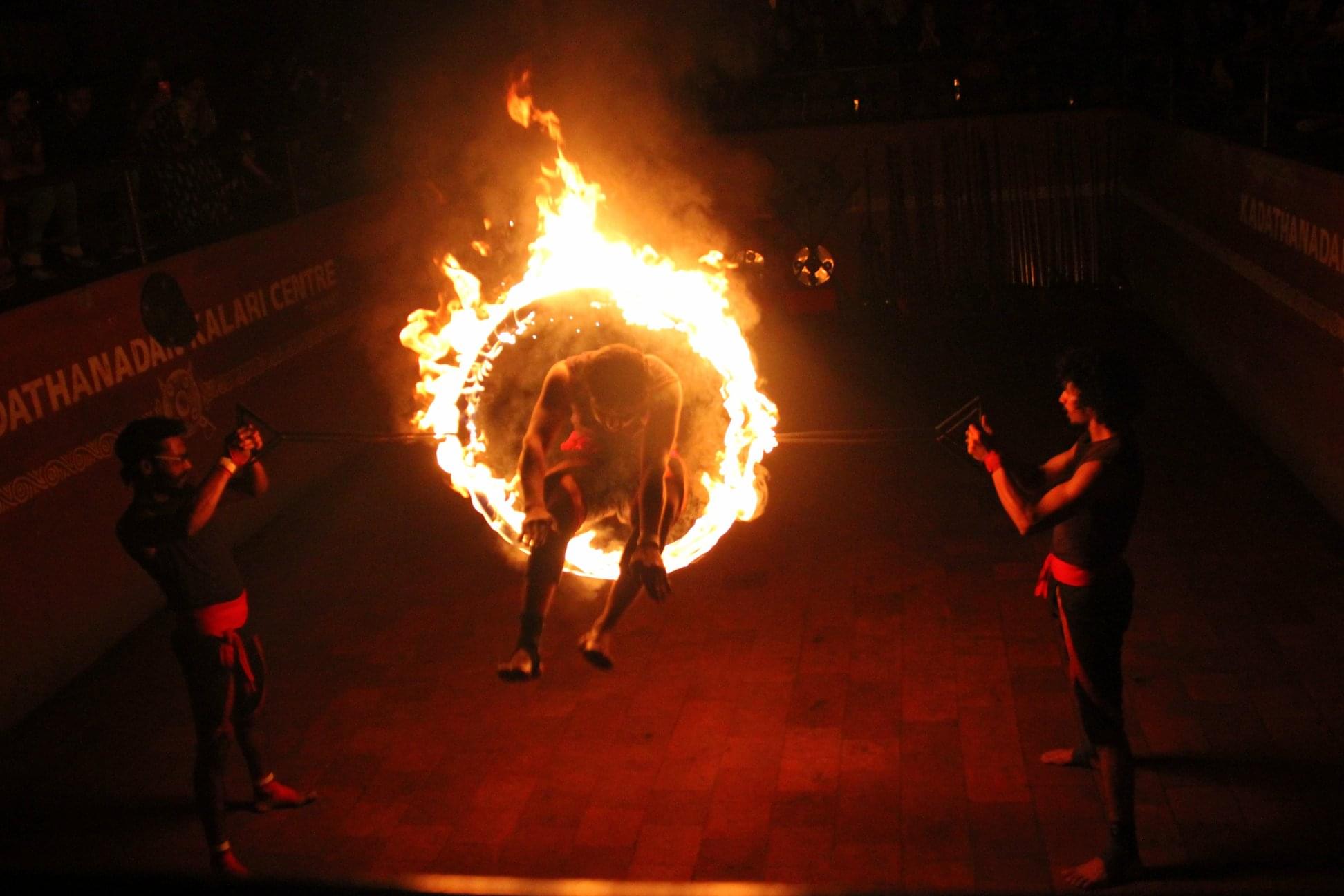Kalaripayattu Show, Thekkady
Kalaripayattu Show in Thekkady Highlights
Immerse yourself in the 3,000-year-old Kalaripayattu, the world’s oldest martial art, performed in an authentic kuzhikalari arena during the 1-hour show.
Witness mastery of traditional weapons like the sword, spear, and the rare urumi, combining deadly precision with artistic beauty.
Enjoy a clear and safe perspective of the action from a specially designed gallery, ensuring immersive engagement for all visitors.
Learn about the origins of Kalaripayattu, linked to sage Parasurama, and its global influence, including its role in shaping Kung-Fu.
Know Before You Go for Kalaripayattu Show in Thekkady
Maps & Location
Kalaripayattu Show in Thekkady Cancellation Policy
- If cancellation is made 15 days or more before the date of travel, no cancellation fees will be charged.
- If cancellation is made between 7 days to 15 days before the date of travel, 50.0% of total booking cost will be charged as cancellation fees.
- If cancellation is made within 7 days before the date of travel, total booking cost will be charged as cancellation fees.
- In the event of unforeseen weather conditions, union issues, government restrictions, or any other circumstances beyond human control, certain trips or activities may be cancelled. In such cases, alternate feasible options will be provided. However, a cash refund will not be available.
Why Choose Thrillophilia
Kalaripayattu Show in Thekkady Overview
Thekkady, nestled amidst Kerala’s verdant landscapes, offers visitors an unforgettable encounter with the ancient martial art of Kalaripayattu. A visit to Kadathanadan Kalari Centre guarantees an awe-inspiring evening showcasing India’s 3,000-year-old warrior tradition. Witness the mastery of Kalaripayattu during an enthralling one-hour evening show from 6:00 PM to 7:00 PM. Set in a traditional kuzhikalari (sunken arena), the performance highlights the art’s legendary origins linked to the sage Parasurama. The well-designed viewing gallery ensures a clear, immersive experience while maintaining safety. This hour-long spectacle not only entertains but also educates, leaving you inspired by the art’s spiritual and scientific essence.
Introduction to Kalaripayattu
Kalaripayattu is derived from the words “Kalari” and “Payattu” in Malayalam, meaning battlefield and fighting or practice, respectively. Together, Kalaripayattu means “training in the art of battle”. It is a martial art form considered one of the earliest fighting techniques in the world. It is not just a combat form, but also a spiritual practice. It is a combination of graceful and precise movements with profound inner understanding.
The martial art emerged more than 3,000 years ago when Kerala's warrior clans and temple traditions developed alongside it. Through the combination of athletic skills and traditional weapons with deep mental concentration, Kalaripayattu transforms an ancient martial art into an extraordinary display.
Kalaripayattu exists today as a complete system which unites physical conditioning with self-control and medical practices, and cultural traditions. Kalaripayattu Thekkady presents Kerala's cultural legacy through its multi-functional role as a protective fighting form and as a spectacular performance.
The History of Kalaripayattu
Kalaripayattu was founded in Kerala around 300 years ago as a combat style for warriors. It is believed that Parashurama, a figure revered as one of Lord Vishnu's ten avatars, founded the art. The art focused on both physical and mental strength, incorporating elements of yoga and Ayurveda. It was closely tied to Kerala’s warrior clans.
Over time, Kalaripayattu Thekkady changed from military training into a spiritual & cultural practice. It flourished under the Travancore kingdom's rule in the 16th century. Several other customary art forms, like Kathakali, felt its influence. British colonial rule saw a decline in native practices. However, Kalaripayattu was revived in the 20th century, gaining further international recognition.
Philosophy and Practice
Kalaripayattu Thekkady is known as more than just a martial art, it is a discipline that trains the body and the mind, as well as the spirit. The practice emphasises self-awareness, inner balance, and respect toward the guru (teacher).
The training for this art form progresses through stages. The students first have to undergo rigorous body exercises for building their strength, flexibility and stamina. They then progress to the first stage, meipayattu (body control exercises), moving on to kolthari (wooden weapons), ankathari (metal weapons), and then finally verumkai (unarmed combat).
The focus includes more than just technique. It is on complete mastery of movement, breathing, and energy flow. Practitioners are further trained throughout marma points, a body of knowledge deeply linked within Ayurveda. These are definite points in the body that can heal or incapacitate. As a result of this, Kalaripayattu is regarded as a practice that trains the entire self in a holistic way.
For those seeking a look into this spiritual discipline without formal training, a Kalaripayattu show Thekkady offers an enticing introduction. These shows stress both physical skills and the ingrained philosophy, making Kalaripayattu a lifestyle.
Training and Techniques
Kalaripayattu Thekkady is a form of Indian Martial art which requires both mental and physical ability. Before each session, the trainees perform warm-up exercises that is meypayattu, or body orientation and body flexion exercises. These exercises help in developing their range of motion, flexibility, as well as endurance and rhythm.
At the beginning of the sessions, they are taught unarmed techniques like strikes, blocks, kapporu, grabs and throws. Later, when the body is agile and no longer brittle, practice extends to weapons. Movements are animal-like, such as the lion, the elephant, and the snake.
These techniques are taught under the supervision of Gurukkal (Kalari master), who also teaches students disciplines beyond the physical craft. The students also learn restraint, modesty, and discipline. These qualities are important in both Kalarippayattu and life. Achieving expertise or mastery takes years and repeated practice, but even the most junior students develop a deep mind-body-spirit connection.
Weapons in Kalaripayattu
Weapons are introduced in Kalaripayattu Thekkady only after a student has demonstrated discipline and control in unarmed combat. Each weapon is more than a tool — it is a symbol of responsibility and mastery, handled with deep respect.
Training progresses through stages, typically in this order:
- Kettukari (Long Staff): A wooden staff used to develop reach, timing, and coordination. Often, the first weapon taught.
- Cheruvadi (Short Stick): Helps refine close-range combat techniques and swift footwork.
- Valum Parichayum (Sword and Shield): Teaches balance between attack and defence, enhancing agility and reflexes.
- Urumi (Flexible Sword): A unique and advanced weapon, resembling a metal whip. Highly dangerous and difficult to master, it requires complete control and awareness.
- Daggers and Knives: Sharpen precision, speed, and control in close encounters.
Training with each weapon emphasises:
- Awareness of the opponent’s movement
- Defensive techniques and timing
- Flowing footwork and body alignment
- Ritual respect and understanding of each weapon’s lineage
Mastery in weapons reflects a student’s growth, not just in their skill, but also in their discipline, responsibility, and a deeper understanding of the Kalari tradition. Watching a Kalaripayattu Show Thekkady allows visitors to see these weapons in action, showcasing agility and precision.
Vital Points and Healing
One of the most intriguing parts of Kalaripayattu is the knowledge of Marma, the vital points in the human body. Utilising fundamentals from Ayurveda, there are 108 marma points that can paralyse, cure or even eventually kill a person. Knowing the spots and their utility alone makes this art a sophisticated science of both destruction and revival.
Masters of this martial art are taught to target these points not only in combat, but also to heal injuries during practice or in daily life. Treatments often include:
- Kalari Chikitsa (Kalari Therapy): It is a traditional healing therapy with herbal medicine, massage, and physical exercises.
- Uzhichil (Ayurvedic Massage): A full-body massage using medicated oils to help improve flexibility, circulation, and recovery.
- Stretching and Rejuvenation Techniques: It basically enhanced reconditioning techniques that are included in practices to prevent injuries and lessen damage during training.
This dual understanding of harm and healing adds a layer of respect and responsibility to the practice. A true Kalaripayattu Thekkady warrior is one who knows how to strike, but also how to heal.
Kalaripayattu Show Thekkady Costumes
Kalaripayattu's aesthetic aspect is persuasively displayed during its performances, where both arts and combat are in sync. The performances are usually held in traditional gymnasiums called `kalaris', which are basically sunken arenas with an earthen floor, lit by oil lamps that cast shadows across the space.
Combatants use simple clothes that do not restrict the movement of the body, so that one can move with ease. These typically include:
- Red or black loincloths (kacha)
- Minimal jewellery or adornment to maintain focus on movement
- Oiled skin to enhance fluidity and protect muscles
Performers display a lot like a scripted play. It starts off with stretching and kicking, proceeding to weapon poses, and ends up with small combats or group acts. The rhythmic breathing of the artists, as well as the slicing sounds of the weapons in the air, add depth to the performance, creating a memorable experience for the viewers.
Watching a Kalaripayattu Show Thekkady is like witnessing a moving sculpture—poetic, precise, and profoundly powerful.
Spirituality and Philosophy
Kalaripayattu has more than bodily skill involved; it's also faith and philosophical thought. Kalaripayattu practitioners do not practice it as a fight to excel in the war but as a careful and dedicated approach towards complete surrender amidst body, mind and spirit.
At its core are indispensable principles that are taken from Ayurveda and yogic traditions. The trainee starts the course by showing respect before the master (gurukkal), and the kalari (training space), but for the knowledge itself. When entering the kalarippayattu training space – the sacred gymnasium of martial arts, the act of bowing before the earth, the weapons, and the lamp symbolises humility, focus, and devotion.
Core Philosophical Values:
- Discipline and self-control as the foundations for strength.
- Compassion and non-violence, despite martial abilities.
- Movement enhances inner balance. Breathing and meditation help to achieve that.
Many Kalaris incorporate breathing techniques, chants (mantras), and even meditation in their routines. The idea is to train a mindful individual-using strategy, one who is calm, aware, and in tune with his world.
In this respect, Kalaripayattu Thekkady reaches deeper than just combat skills. It helps a wrestler to increase their strength, respect for others, and thinking power. This practice is not only useful for wrestlers but for every other person whose path is inclined towards inner growth.
If anyone is eager to see an artistic representation of Kalaripayattu, a Kalaripayattu show Thekkady is a must-watch. When you see a Kalaripayattu show, you are treated to a performance that combines art and athleticism.








